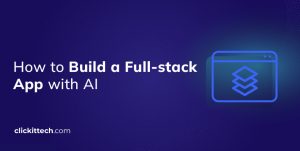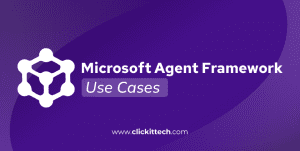Did you know that 79% of healthcare organizations already use AI to improve patient care? That’s why I will show you how to build an AI-based app for healthcare. As digital health grows, AI is helping doctors detect problems, monitor patients, and provide better treatments. But how exactly do you get started with building such an app?
Step 1: Define the Use Case
First, to build an AI-based app for Healthcare, you need to narrow your focus and define a very specific use case with clear value. For example, you might build a solution that alerts doctors when a patient in the ICU shows early signs of sepsis, or you might automate the classification of skin lesions using smartphone images.
Each problem has its own data types, risks, and ethical considerations. This is why involving domain experts early in the process is essential. Doctors, nurses, and healthcare workers can tell you what no dataset ever will. They’ll help you separate technical possibilities from what’s clinically relevant and usable.
The goal here is not to apply AI to a problem simply because it’s trending; it’s to address a specific pain point that improves outcomes or reduces the burden on healthcare providers.
Step 2: Gather and Prepare Medical Data
Healthcare data is sensitive, regulated, and often messy, unlike other industries. You might need to work with electronic health records, medical imaging files, sensor data from wearable devices, or even handwritten clinical notes. Even the most advanced AI can fail if the data used for its training is not solid.
You must ensure the data is cleaned and structured so your AI models can understand it. At the same time, you must respect patient privacy at every stage. This includes anonymizing data to remove personal identifiers, obtaining proper patient consent for data usage, and complying with legal regulations.
These aren’t optional steps. A data privacy violation can shut your project down and create serious ethical consequences. If you’re working with real patient data, security is essential. Your pipeline should include encryption and traceability right from the start. During early development, consider using synthetic or publicly available datasets.

Step 3: Build the AI Model
Once your data is ready, the real technical work begins. Now you have to build your AI model. This is where you will have to use your machine learning skills. You’ll need to choose a suitable programming language with the right libraries. Your approach will depend entirely on the nature of your data and the use case selected.
For example, analyzing medical images, like detecting pneumonia in chest X-rays, brings you into the field of computer vision. Here, convolutional neural networks have proven to be incredibly effective. These models can learn to recognize subtle patterns that even human radiologists might miss, provided they’re trained on high-quality labeled images.
You’re working with unstructured text if your app uses clinical notes, discharge summaries, or doctor-patient conversations. This is a great use case for natural language processing. At this stage, you’ll likely experiment with different model architectures. You’ll also need to tune hyperparameters. Also, evaluate your training results carefully to avoid overfitting or poor performance.
Read our Blog on How to Build Predictive AI Models!
Step 4: Validate for Accuracy and Compliance
When building a AI-Based App for Healthcare, validation isn’t just about getting good scores in your test set. It means verifying that your model produces safe, fair, and meaningful results when deployed in clinical workflows. This involves simulating real-world situations, testing with rare cases, and ensuring the AI performs fairly across all types of patients.
More importantly, this is also the stage where you must involve compliance officers and legal advisors. Depending on your region and the purpose of your app, regulatory frameworks, such as FDA approval or CE marking, may apply. Your model’s predictions may need to be explainable.
In other words, a doctor must understand why the AI reached an inevitable conclusion. Black-box models without explainability can be rejected or banned for many use cases, especially those affecting clinical decisions. So, model validation here isn’t just about accuracy. It’s about accountability, transparency, and building trust in a field where trust is needed.
Step 5: Develop the App and Integrate the AI
Once your model is deemed reliable, it’s time to build an application that will connect everything. This is where software engineering meets machine learning. You’ll need to create a front-end interface, either a web or mobile app, that doctors, nurses, or patients can easily interact with.
This front-end must communicate with a secure backend that handles user data, processes AI inferences, and connects with external systems like hospital databases, wearable devices, or IoT sensors.
But the real challenge is integration. Your AI doesn’t live in a vacuum. It must work with existing electronic health record systems, lab information systems, and remote monitoring devices.
This means working with APIs and handling data streaming. It also involves setting up your backend architecture to support secure data transfer and real-time processing. Your infrastructure must also follow healthcare standards like HL7, which govern how clinical data should be formatted and exchanged. The smoother your integration, your app will likely be adopted in the real world.

Step 6: Deploy and Monitor
Finally, it’s time to launch. But in healthcare, deployment is not just a technical milestone; it’s a commitment. You’re putting an AI system into an environment where decisions impact lives. Most teams choose cloud platforms like AWS, Azure, or Google Cloud for hosting, since they offer built-in support for encryption. But the job doesn’t end with a successful deployment.
This includes tracking how well your AI model is making predictions, how users interact with the interface, and whether the system stays online and responsive under load.
Over time, the quality and distribution of input data might change. This is known as data drift, and it means your model could become less accurate.
To keep your model effective and safe, you must regularly retrain it with new data. You’ll also want to build alerting systems for anomalies, logging mechanisms for audits, and analytics dashboards for stakeholders. Deployment marks the start of an ongoing relationship with your app that needs continuous monitoring, updates, and improvements.
Key Technologies for an AI-Based App for Healthcare
Python
Remains the language of choice for most AI developers, thanks to its simplicity, library support, and strong community in the AI and healthcare tech space.
TensorFlow and PyTorch
Each has its strengths. TensorFlow is recognized for its strength in production-ready deployment and mobile support. PyTorch, however, stands out in research and rapid prototyping.

OpenCV
OpenCV provides powerful tools for image processing and analysis if your app handles visual data like X-rays or skin lesion images.
spaCy or Hugging Face Transformers
For working with medical text like discharge summaries or doctors’ notes, NLP libraries such as spaCy or Hugging Face Transformers allow you to build language understanding into your system. Cloud infrastructure plays a major role behind the scenes.
AWS and Azure
Platforms like AWS and Azure offer healthcare-grade security and compliance features out of the box.
Docker and Kubernetes
When building apps for hospitals or clinics, Docker makes it easier to scale by keeping everything organized in containers. Kubernetes management ensures that your AI services are efficient, scalable, and simple to manage.
ClickIT’s Healthcare Success Stories
At ClickIT, we’ve helped healthcare companies leverage AI to address complex and critical challenges.
One example is our collaboration with CareSpace, which pivoted quickly during the COVID-19 pandemic to build a solution for rapid health monitoring. They weren’t just launching an app; they were integrating physical IoT devices that measured body temperature into a secure, cloud-based platform.
They needed speed and precision. We partnered with Microsoft Azure’s IoT engineers to design an infrastructure-as-code solution using Terraform. The architecture supported both shared and isolated multi-tenancy models and balanced cost-efficiency with performance depending on the client’s needs. Most importantly, we automated deployments and strengthened security. Therefore, CareSpace was able to respond quickly to a global crisis.
Another company we worked with is Ultrasound AI. It transforms prenatal care using artificial intelligence. They aimed to accurately predict delivery dates by analyzing ultrasound images through a web-based platform.
This required advanced image processing, strict HIPAA compliance, and scalability. We built microservices in Python, deployed them on AWS using Kubernetes and EKS, and implemented data processing through MongoDB Atlas.
The result? A secure, high-performance system that now delivers clinically validated, AI-based guidance to expecting mothers worldwide.
If you are looking for a partner to help you build an AI-Based App for Healthcare or any other indusry, book a call!






